NEWS RELEASES
FOR IMMEDIATE RELEASE
May 21, 2008
Sandia researchers aim to mitigate impact of unintended hydrogen leaks by examining 'embrittlement' issues

Sandia postdoc Kevin Nibur assembles a pressure vessel and manifold on a mechanical test frame for a test of how containment materials react to dynamic loads in high-pressure hydrogen gas. This high-pressure hydrogen test lab is the only one of its kind in the U.S. and only one of three in the world. (Photo by Randy Wong)
Download 300dpi 21MB JPEG image (Media are welcome to download/publish this image with related news stories.)
LIVERMORE CALIF. — Materials researchers across the globe have fervently been working to find the ideal hydrogen storage material, one that will safely and efficiently provide the needed range and running time for fuel cell vehicles. But a separate issue — hydrogen “embrittlement” — is an equally challenging technical hurdle that has gone largely unnoticed by the general public.
Researchers at Sandia National Laboratories in Livermore, Calif., however, have quietly been tackling the problem for years. Sandia is a National Nuclear Security Administration laboratory.
Hydrogen embrittlement is not unique to on-board storage, but automotive applications are the focus of Sandia’s current research. In terms of on-board storage, Sandia materials scientist Brian Somerday says hydrogen embrittlement can be defined as the cracking or fracturing of the outside wall of a hydrogen storage tank. It occurs because of the unique structure and absorption qualities of hydrogen and can lead to unintended leaks.
“Because of its small size, hydrogen can readily diffuse (scatter or disperse) into materials at room temperature,” says Somerday. “Other gas species can promote embrittlement of structural materials, but the mobility of hydrogen at room temperature makes it unique as an embrittling agent.”
This means the hydrogen is easily absorbed by other materials, which is a useful scientific phenomenon when the goal is to store hydrogen in a metal hydride material for onboard storage. “But for the automobile’s fuel tank itself,” says Somerday, “the risk of embrittlement – and subsequent leaks – is a concern.”
Materials scientists have been working on hydrogen embrittlement since long before the term “hydrogen highway” joined the vernacular.
“This is not a new phenomenon, but one that has been studied for decades,” says Somerday, who was hired by Sandia 10 years ago to work on hydrogen embrittlement in relation to gas transfer systems. Currently, his efforts support the FreedoomCAR and Fuel Partnership and are focused on low-cost steels, aluminum alloys, and stainless steels. His primary interest is what happens structurally to those materials when exposed to hydrogen.
“By measuring the structural properties of the materials, quantifying the degree by which they will degrade when stressed in hydrogen, and simulating the cracks that occur in the structural material, we can minimize the impact of the embrittlement through proper design,” says Somerday. The ultimate goal, he says, is to eliminate the possibility of embrittlement altogether.
A scientific level of understanding, he says, will help provide guidance for storing hydrogen for automotive purposes — whether in an onboard fuel tank, a storage tank at a refueling station, or piping that hydrogen might flow through between the two. The researchers, says Somerday, are interested in anything that might come in contact with high-pressure hydrogen. The results of Sandia’s research will facilitate decisions such as what structural materials to use for hydrogen storage and the lifespan of such materials.
Sandia, Somerday says, is one of only a few research institutions currently studying the embrittlement issue. One of its lab capabilities allows researchers to subject material specimens to dynamic loads in very high hydrogen gas pressures (other systems generally only offer much lower pressure capacities).
Due to his expertise and knowledge of the subject, Somerday will serve as a faculty member at the Third European Summer School on Hydrogen Safety, to beheld later this summer at the University of Ulster (Belfast, UK). He’ll teach a two-part course titled Hydrogen Effects in Materials, while his Sandia colleague Jeff LaChance will lead a quantitative risk assessment course.
Sandia is a multiprogram laboratory operated by Sandia Corporation, a Lockheed Martin company, for the U.S. Department of Energy’s National Nuclear Security Administration. With main facilities in Albuquerque, N.M., and Livermore, Calif., Sandia has major R&D responsibilities in national security, energy and environmental technologies, and economic competitiveness.
Sandia news media contact: Mike Janes, (925) 294-2447, mejanes@sandia.gov